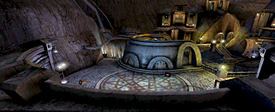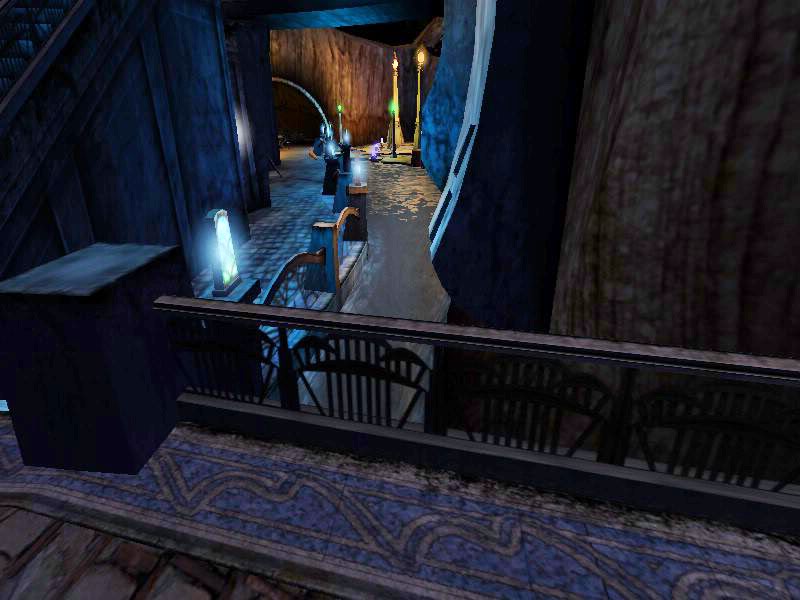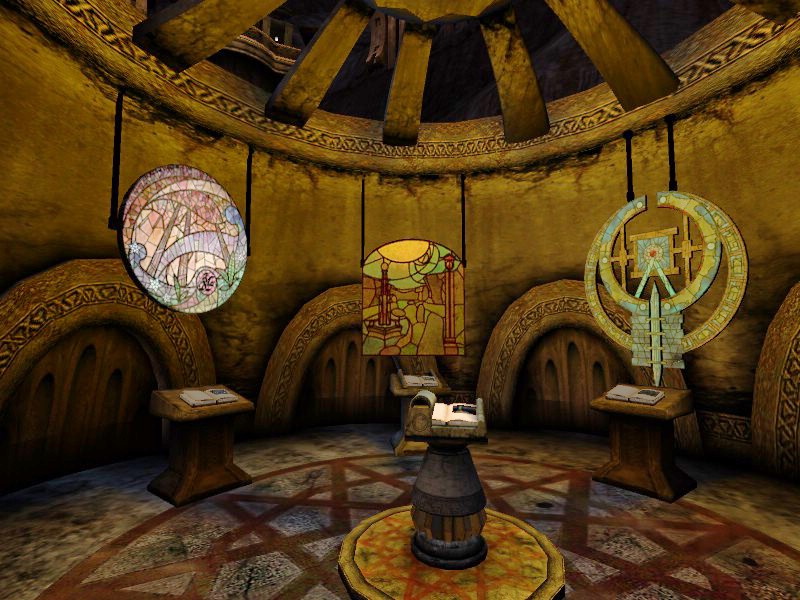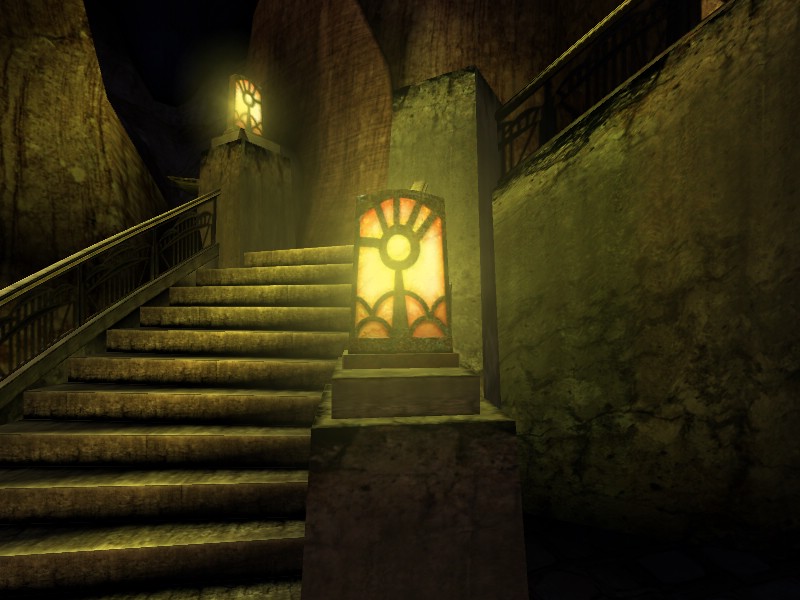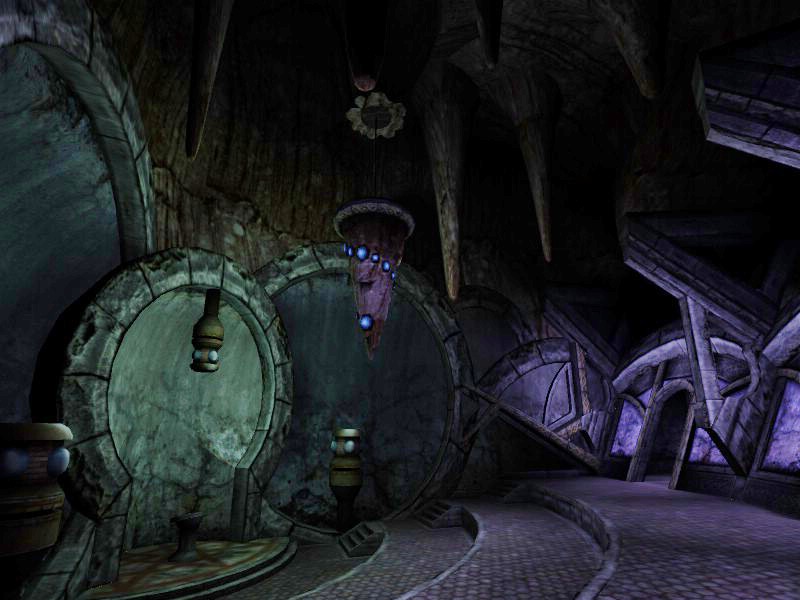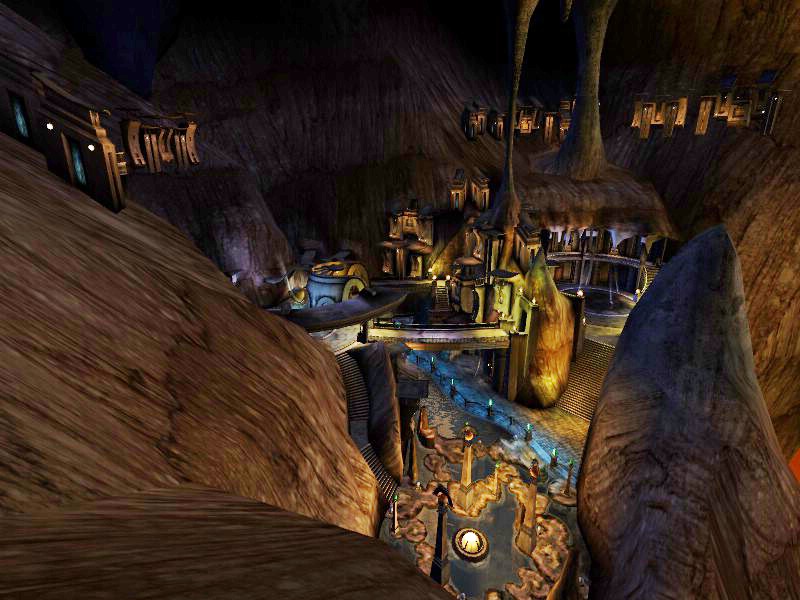

|
|
The neighborhoods are small communities set in niches in the wall of the D'ni cavern. We know of three names for them, Bevin, Seret, and Kirel. According to Richard Watson, the meaning of the names is unknown, but there is unconfirmed speculation that they are names of the people who designed a particular neighborhood. Each has a waterfall, fountain, Garden of Lights, community room, classroom, common library, central clock, and a main residence with a large balcony. They also normally have a community Ahyoheek table. My own speculation is that the neighborhoods might have been middle-class residences devoted to extended families or clans, with a given clan owning one or more neighborhoods. The home with the balcony would have been for a community leader or family head, if my theory is correct. The neighborhoods have an identical copy of a rock tablet with a Bahro petroglyph placed on the balcony, blocking the door into the main residence. The only way to reach the balcony is by Bahro stone. The pictographs on the stone represent the Path of the Hand, Yeesha's first quest for the gathered, which is the name given in Words of the Watcher for explorers called to the cavern. The top section shows a pillar from the Bahro cave in the ceiling of Rudenna cavern moving to a Relto and then back. The lower section shows the cave with the star field below it, a group of Bahro with the "weeping eye " symbol, and the cave with Rudenna below it, which the explorer sees as he or she progresses through the quest. The weeping eye is a symbol for which many ideas have been proposed. One of those ideas is that it is open to show that the Bahro are always watching and waiting, even in their dispair. However, there is no written evidence for any of the proposed meanings, and neither Yeesha or the DRC have ever spoken of it. The one thing that is evident is that the Bahro used it frequently, and it can often be found drawn around their images of themselves, either separately or on their bodies. This tablet shows both. It is one of the ways that signifies figures in a petroglyph are meant to represent Bahro.
Time and space being as twisty as it is in the Ages because of the influence of the Bahro and Yeesha, it's very likely that there are only two physical neighborhoods. The many Bevin and Seret style neighborhoods we can visit are most likely to be instances of the same place. This idea would explain why they are all identical down to the placement of stalactites and stalagmites. Support for the theory can be found by checking your KI, if you have it fully activated. The coordinates of the spot where everyone links in is 60265, 999, -71 for all of the neighborhoods except Kirel. The link in spot for Kirel is 60040, 1036, -103. These coordinates are for the angle offset from the zero line, distance, and elevation above or below the zero marker. That means that there is a 225 torantee angle between Kirel and the other hoods, a 37 shahfeetee difference in distance from the Great Zero, and a height difference of 32 shahfeetee between them. That puts the two areas roughly side by side, but at different altitudes and distances. In US measurements, that's a difference of about 1° in angle , 493' in distance, and 426' in height. It also places the residential neighborhoods about 294 feet (89.5 meters) above the lake's surface.
The neighborhoods are decorated with the same themes that are found throughout the City. The two main railing designs found on Ae'gura are here as well. This picture shows a dripstone railing design.
This railing has a typical Kerath's Arch design.
Access to most the homes in the neighborhoods are by doors set along the walkways. There are two doors behind the fountain and leading under the community room that must lead to stairs for the homes high on the cave side above the community room. There is also a door on the lowest level, not far from the Garden of Lights that seems to be a second entrance to the home above it, or perhaps it's a lower story apartment. There is a home under the common library, and ones above the class and meditation rooms, which have no apparent access door. Explorer Zeke365 found a door in the back of the classroom that might be the access to the tunnels leading to the homes above the classroom and below the common library. It is very difficult to see, because it's tucked into a dark niche in the corner of the classroom farthest from the entrance door. These are color-enhanced copies of photographs Zeke365 took of it.
Three of the doors in the neighborhoods are marked with what may be addresses; only those three doors have them. The numbers are in 4-digit groups, and all of the digits are between 0 and 9. All of the numbers are set in bars, instead of individual boxes. On the inside of the corridor, there is one door marked 4649.
On the other side of the corridor, there are two doors that are marked 6497 and 7840. The numbers do not appear to be sequential, although they rise in count. Number bars in D'ni math usually represent extended numerical values rather than individual numbers, although addresses may be an exception to the rule. If read as a math statement, 4649 would be 66,359, 6497 would be 96,482, and 7840 would be 114,475. However, they make even less sense if read that way.
The classrooms: In each neighborhood, there is a classroom where D'ni children were home-schooled. The characters for D'ni numbers and letters are written around the top of the walls. The ceiling of the room is a star field painting. Whether this was for beauty or served an instructional purpose is unknown to me.
The stained glass panels: In most neighborhoods, there are stained glass panels to identify books in the common libraries. Each common library has four linking books: one to a garden age (either Eder Delin or Eder Tsogal), one to Gahreesen so that citizens can collect a KI (this was provided just before the Fall), one to the Great Zero so that the KI can be calibrated, and a linking book to the Nexus Age. In most neighborhoods, the Bahro added a pedestal with a stone that links to a shadow of Ae'gura. Why they did so is a mystery. The stained glass panels each have three variations. In these photos, I hung the panels for the two garden ages in the same shots for convenience. They cannot be found together normally. The stained glass panels were not present during the time of the D'ni. They were placed by the DRC for the benefit of explorers, and were restored by explorers in a series of contests held by the DRC in AD 2007. The three Gahreesen panels: This panel was created by Beefo laRue.
This panel was created by Greg Dean.
This panel was created by Gregory Champoux.
These are the panels for Eder Delin, Eder Tsogal, and the Great Zero, along with the names of the explorers who restored them. From left to right, Eder Delin by Rustee, Eder Tsogal by Barbara, and the Great Zero by Mister Cloak.
From left to right, Eder Delin by Zalion XI, Eder Tsogal by Moiety Jean, and the Great Zero by Resolute Guardian.
From left to right, Eder Delin by Ekis, Eder Tsogal by Cycreim, and the Great Zero by Tweek.
Bevin: Bevin is the name for a specific neighborhood, but because most of the neighborhoods seem to have been created in its style, the DRC sometimes called any neighborhood like it a "Bevin". An overview of Bevin. Seret appears the same:
The lamps in Bevin have a D'ni design overlaid on them called the Hand Tree:
The community room, where meetings and lectures could be held. The podium at the front of the room contains a sound player called a cannen, and the three devices surrounding the podium are speakers. This allowed lectures or speeches to be prerecorded and played later. The community rooms in Seret style neighborhoods look the same. During the time of the DRC, the sound system could also relay messages from a central broadcasting location. The keyhole shaped surface behind the podium is a sound reflector. Note the "chandelier" is a sawed-off stalactite that has been reattached with a chain.
The cannen in the pedestals in Kirel and Bevin contained messages in the past. One message was from Dr. Watson, welcoming new explorers to the cavern. The other was a garbled recording in D'ni which seemed to talk about a person from the surface. The latter message is very hard to make out, so that interpretation cannot be confirmed with any certainty. Kirel: Kirel was the first neighborhood that was discovered, and was the headquarters of the DRC until Tokotah I was declared fit for habitation. It is a mirror image of Seret, with blue lenses on most of the lamps. To date, only one neighborhood in this style has been made available to explorers. Overviews of Kirel:
The lamps in Kirel have blue tinted lenses with a stylized bee design.
A lamp in the Kirel meditation chamber:
Kirel's community room is also lit mostly in blue:
Seret: Seret is a neighborhood that is nearly identical to Bevin, except that the lamps use the Bee design. The first neighborhood of this style discovered did not have a telescope or a working Ahyoheek table. It is also a common template for the neighborhoods that have been been made available for explorer use. An overview of Seret:
The lamps in Seret have the stylized bee lens design, this time with a golden tint.
A lamp and vase in the Seret meditation chamber:
The vase has what appears to be D'ni writing on it, but it's very obviously not an object dating back before the DRC because the language is English, and just uses D'ni characters. Laid out flat, here is the phrase.
Transcribed character for character, it reads "water will flow". Had it been written in D'ni, it would have read: "ano boremen", and would have looked like this. . As it turns out, there was a very simple reason for it. The vases were commissioned and distributed to the neighborhoods by the DRC. They were a reward for a contest in which explorers were invited to design vases using D'ni styles. The winner who designed the colors and patterns seen on this vase was explorer Svein Rune Reinhardtsen. In all of the neighborhoods, there are two copies of the message that is found in many places on Ae'gura Island. The first is above the door to the classroom, and the second is above the door to the meditation chambers. They are the same sentence that can be found on Kerath's Arch, the Ferry Terminal, the Canyon Mall, and the Great Library. The writing reads "rebantano tānēen shemtē", and means "the island welcomes you". There was a statement by Richard Watson that those panels were never intended to be there. That leads to a theory that those panels are not original, but were placed there by DRC restoration engineers. My own take is that they may have once been names or descriptions of the chambers below them, but were, perhaps, so damaged that the ResEngs simply replaced them with copies of the only D'ni message they knew of from the outside of a building — the Island welcome message.
Ahyoheek In each of the Seret and Bevin style neighborhoods, a game table can be found on the lowest level near the Garden of Lights. These tables are for a game called ayohEk (Ahyoheek), which we know was rather popular at the time of the Fall, along with a board game called gemedet (Gemedet), whatever team game that was played in the Age of jalaK (Jalak), and the arena spectacles of the Age of lakE'an (Laki'ahn). The game is very much like rock-paper-scissors, although the symbols are pen-beetle-page. Points are awarded for each win, defeat, or tie in a round, and the winner of the round is determined by the points. The object of Ahyoheek is to collect three of a given symbol, with the winner of a round collecting one of the symbol he or she used. The rank for each symbol is: Pen defeats beetle.
The DRC published this pamphlet for the game.
|
Myst, the Myst logo, and all games and books in the Myst series are registered trademarks and copyrights of Cyan Worlds, Inc. Myst Online: Uru Live is the sole property of Cyan Worlds Inc. The concepts, settings, characters, art, and situations of the Myst series of games and books are copyright Cyan Worlds, Inc. with all rights reserved. I make no claims to any such rights or to the intellectual properties of Cyan Worlds; nor do I intend to profit financially from their work. This web site is a fan work, and is meant solely for the amusement of myself and other fans of the Myst series of games and books. |

